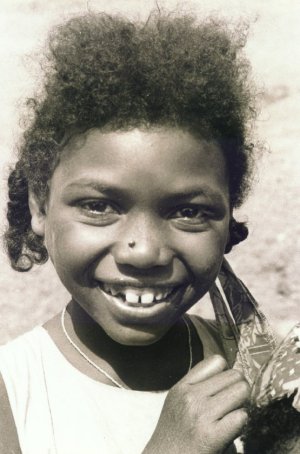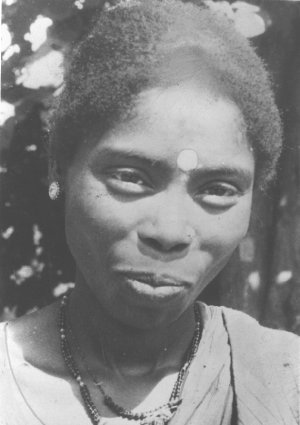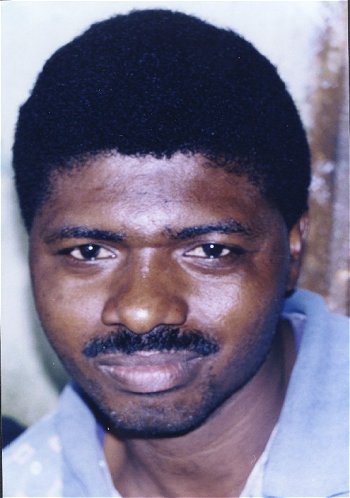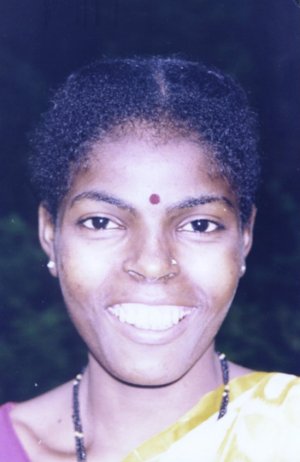| Author |
Message |
    
Brownbeauty123
Veteran Poster
Username: Brownbeauty123
Post Number: 1990
Registered: 03-2006
Rating: 
Votes: 1 (Vote!) | | Posted on Monday, May 07, 2007 - 07:45 pm: | 



|
Another legacy of British colonialism destroying African descendants
Photo © Salomé/Survival
When you come across groups of people that were there before the Aryans, it conflicts with their world view.
Horen Tudu, Researcher and writer
They are beautiful, dark-skinned black people, with natural Afro kinky hair and are shorter than the average height. They came from Africa around 60,000 years ago but today are threatened with extinction because of their blackness.
There are no precise figures as to how many Jarawa people there were before the British invaded and colonised the Andaman Islands in the 1850s. Along with other indigenous peoples: the Sentinelese, the Onge and the Great Andamanese, they were once the sole inhabitants of the Andaman Islands and have lived there for around 60,000 years.
After the end of British colonial rule, the Andaman Islands became part of India and several thousand people left the Indian mainland to settle there, outnumbering the indigenous groups. The Jarawa, Onge and Great Andamanese peoples all came from Africa and were the earliest people to inhabit India.
The Great Andamanese were decimated by the British and their numbers fell from 5000 at the time of the British invasion, to only 53 today. The remaining Great Andamanese are plagued by alcoholism and dependent on government handouts. There are only 100 Onge people left out of 600 and the Jarawa are thought to number around 300 today. Their population level has remained stable in recent years.
In 1957 the Indian government established a reserve for the Jarawa on the Andaman Islands and it is illegal for outsiders to enter this area; but in the 1970s it built a highway right through the reserve, which brings the Jarawa into daily contact with outsiders – something they had vigorously resisted.
The road is used by other local settlers as a convenient way of entering the Jarawa reserve, leaving them exposed to exploitation, poachers and racial and violent abuse. In 2002, the Supreme Court of India ruled that the road had to be closed, but the ruling has yet to be implemented. Survival, an international NGO that supports indigenous nation groups worldwide, has been campaigning for the road to be closed.
Spokesperson Miriam Ross told Black Britain: “Outsiders are going into the Jarawa reserve, stealing their animals and giving them alcohol…often with the complicity of local police.” Local opposition to the road closure has intensified as local settlers with business interests in the vicinity have protested it should stay open. The Andaman Administration has since petitioned the Supreme Court to revoke its order to close the road.
Survival feels that the Indian Government has developed good policies to protect the Jarawa but “lack the will to implement them,” a view shared by Horen Tudu, a US-based researcher and writer who was born into the Santhal tribal group in Bangladesh. He said: “The Indian government has no interest preserving these people at all.”
According to Tudu, the Indian Government sees itself as more cultured to Aryan supremacist beliefs that dictate that Aryans are indigenous to India: “When you come across groups of people that were there before the Aryans, it conflicts with their world view.”
Tudu told Black Britain that some Indian scholars would like nothing better than for people to believe that the Caucasian race originated in the Indian subcontinent: “They would like people to believe that other groups of people who are basically the parent people of all the Austro-Asiatic and tribal people that you see in south Asia and south-east Asia never existed.”
Tudu believes that the present threat posed by outsiders to the Jarawa people is history repeating itself.
omplicit police who collude in Jarawa exploitation are mainly high caste Brahmins
Photo © Salomé/Survival
There does need to be guards to some extent patrolling their territory and keeping out these illegal poachers, because the Jarawa are so outnumbered by Indian settlers.
Miriam Ross, Survival
When Aryans invaded the Indian subcontinent the indigenous peoples resisted and fought back, but they were subdued and some of them were enslaved and eventually relegated to the margins of society as untouchables. Those who fled to the hills are today’s tribal people who have chosen to retain their traditional culture and way of life.
Today’s battle is much the same with some Hindus intent on dispossessing the black indigenous peoples of their land and resources. Tudu told Black Britain that this is a conscious effort on the part of Indians to disconnect themselves with the indigenous black people of the Indian subcontinent and their African heritage: “They want to remove the whole image of themselves from anything that is non Caucasian,” he said.
The Jarawa people have been struck by two recent measles epidemics which have resulted in at least one death. But there is still a possibility that they could be adversely affected by other diseases. In recent decades, other indigenous communities, like those in Brazil, have seen 50 per cent of their population wiped out through diseases brought in by outsiders.
The decimation of the Great Andamanese people, according to Tudu: “Has to do with the spread of diseases like Bronchitis, the measles and syphilis, a sexually transmitted disease, which only came about through rape.” There are also reports that Jarawa women are being sexually exploited by local settlers.
Ross believes that the Indian government has failed to realise the real risks to the Jarawa people. “An epidemic could still wipe out the whole Jarawa population,” she explained. Ross told Black Britain that the only way for the Jarawa to be saved is by ensuring that they are afforded proper protection- even if it means installing a permanent convoy of troops: “There does need to be guards to some extent patrolling their territory and keeping out these illegal poachers, because the Jarawa are so outnumbered by Indian settlers.”
Aside from military protection, an education programme is essential if people’s attitudes are to change: “…local officials who have dealings with the Jarawa, police stationed around the reserve, the administration’s tribal welfare officers…they have to understand about the Jarawa’s rights, needs and way of life,” Ross said. The local administration recently held a training event for local police officers to sensitise them to the needs of the Jarawa.
Tudu pointed out that the reason for the complicity on the part of Indian police is due to the fact that around 80-90 per cent of police officers are upper caste Brahmins and the rest are other upper castes, for whom anti black racism is deeply embedded in their psyche: “Government officials and local government jobs are done by Brahmins. They hold on to all the employment opportunities that could be availed to anyone, even though they are only 5 per cent of the population.”
Survival believes that the sensitisation should be extended to local Indian settlers. As well as hunting animals in the Jarawa’s reserve, which is prohibited, they have also taken to luring the Jarawa to hunt for them whilst bribing them with alcohol, tobacco and rice, creating dangerous addictions, as well as an unhealthy dependency on outsiders. In essence, they are being used as “manual labour.”
As black people in India, the Jarawa are exposed to racism, not least because of caste discrimination, which places them at the bottom of a skin tone, racial hierarchy.
Genocidal campaign against the Jarawa is a continuum of the African Holocaust
Photo © Salomé/Survival
Anti black racism is …the most dangerous thing in the world today that needs to be addressed.
Horen Tudu, Researcher and writer.
Racist attitudes can also be traced back to colonisation, which brought with it the ideology that the Jarawa people and other indigenous groups were ‘primitive’ and ‘backward’ and need to be ‘civilised.’
“Local people and the local authorities have tried to get the Jarawa to wear clothes and adapt to the mainstream, Indian-settler lifestyle…but obviously that displays a deep-seated racism and belief that the Jarawa’s hunter-gatherer way of life is inferior,” Ross told Black Britain.
Tudu explained how dangerous these beliefs are to the Jarawa and the threat they pose to their ultimate survival: “You once had proud communities, but now the infrastructure has been decimated and they interfered with the indigenous methods of procuring food.”
Tudu told Black Britain that the Jarawa and other nation groups on the Andaman Islands have been deliberately encouraged to abandon their traditional lifestyle and assimilate into the mainstream, which ties them into the economy: “When they exist outside the mainstream economy they are more self-sufficient, once they are encouraged to do other things they get dependent on currency.”
Survival points out in a report submitted last week to the UN Committee on the Elimination of Racial Discrimination , that the Indian vocabulary reflects the government’s racist attitudes towards indigenous peoples living within the Indian subcontinent. The 75 nation groups are referred to as ‘Primitive Tribal Groups’ which has been challenged.
New draft policy drawn up in 2004 acknowledges that the name ‘primitive’ has derogatory overtones and should be abandoned. However, the proposed alternative ‘Particularly Vulnerable Tribal Groups’ is equally questionable. The draft policy acknowledged the rights of the Jarawa people and promised minimal intervention in their lives and complete autonomy.
But the rhetoric has not been transformed in practice. Jarawa people who have to attend hospital are given clothes and food, but clothes can present problems when they are not used to wearing them as they usually remain unwashed and cause skin diseases. Jarawa are also being kept in hospital for minor ailments such as coughs and colds, putting them at risk of infectious diseases.
Survival points out that this practice only serves to “undermine confidence in their own medical practices and way of life.” Ross told Black Britain: “Out of everyone who lives on the Andaman Islands, they are the ones who have an intimate knowledge of its ecology and natural history.”
Survival is campaigning to try to change attitudes and blames the media for sometimes referring to indigenous people as ‘primitive’ societies. This gives the impression that indigenous people are not progressive, but Ross stressed that they do adapt, albeit in different ways to mainstream societies. But it is not only the media who are at fault.
The education system also has a lot to answer for. It does not present a world view of history and development, but perpetuates the view that the era of the British Empire was a positive episode in history, presenting colonisation as a necessary act of civilising ‘backward’ people, rather than a genocidal, immoral, and undesired invasion borne out of a desire for economic exploitation and political domination of the African, Asian and Caribbean continents.
Tudu told Black Britain: “Anti black racism is …the most dangerous thing in the world today that needs to be addressed.”
In essence, the genocidal campaign against the Jarawa and other indigenous black peoples throughout the world is a continuum of the Maangamizi, (African Holocaust), which needs to be urgently addressed, not only by the United Nations but by the African Union as part of an international dialogue on reparations.
|
    
Brownbeauty123
Veteran Poster
Username: Brownbeauty123
Post Number: 1991
Registered: 03-2006
Rating: N/A
Votes: 0 (Vote!) | | Posted on Monday, May 07, 2007 - 08:01 pm: | 



|

|
    
Brownbeauty123
Veteran Poster
Username: Brownbeauty123
Post Number: 1992
Registered: 03-2006
Rating: N/A
Votes: 0 (Vote!) | | Posted on Monday, May 07, 2007 - 08:02 pm: | 



|

Hard working Siddi woman |
    
Brownbeauty123
Veteran Poster
Username: Brownbeauty123
Post Number: 1993
Registered: 03-2006
Rating: N/A
Votes: 0 (Vote!) | | Posted on Monday, May 07, 2007 - 08:02 pm: | 



|
Afro Indian Youth
 |
    
Brownbeauty123
Veteran Poster
Username: Brownbeauty123
Post Number: 1994
Registered: 03-2006
Rating: N/A
Votes: 0 (Vote!) | | Posted on Monday, May 07, 2007 - 08:12 pm: | 



|
 |
    
Renata
AALBC .com Platinum Poster
Username: Renata
Post Number: 2144
Registered: 08-2005
Rating: N/A
Votes: 0 (Vote!) | | Posted on Tuesday, May 08, 2007 - 05:54 am: | 



|
I'm REALLY curious as to what Siddi means now. Siddiqui is a common name in Pakistan (where the people are actually quite pale, like Gujaratis). Surely Siddi and Siddiqui must have come from the same root word or similar meaning at least. |
    
Renata
AALBC .com Platinum Poster
Username: Renata
Post Number: 2145
Registered: 08-2005
Rating: N/A
Votes: 0 (Vote!) | | Posted on Tuesday, May 08, 2007 - 05:59 am: | 



|
Those Indian muthafuckas know they come from Africa. Dravidians are DARKER skinned than the obviously black people you posted here and are darker skinned than black Americans. You just don't see them often on television/media. |
    
Latina_wi
Regular Poster
Username: Latina_wi
Post Number: 350
Registered: 08-2006
Rating: N/A
Votes: 0 (Vote!) | | Posted on Tuesday, May 08, 2007 - 11:40 am: | 



|
This is sad but doesn't exactly surprise me. Aboriginal Indians are extremely dark (like these people, or Sri Lankans) but, like this quote proves, some would like people to believe they aren't originally that way at all.
Tudu told Black Britain that some Indian scholars would like nothing better than for people to believe that the Caucasian race originated in the Indian subcontinent: “They would like people to believe that other groups of people who are basically the parent people of all the Austro-Asiatic and tribal people that you see in south Asia and south-east Asia never existed.”
One of my Indian friends explained to me why there was so much self-hatred when it came to dark skin and that one of the reasons that Sri Lankans (many of the women are extremely beautiful in my opinion) would never be considered 'nice to look at' in India. Not only because political 'beef' but due to Bollywood's view on what makes you beautiful. Bollywood has a lot of clout in India and like the American media decides a lot of 'in things' for the public.
|
    
Doberman23
Veteran Poster
Username: Doberman23
Post Number: 996
Registered: 01-2006
Rating: N/A
Votes: 0 (Vote!) | | Posted on Tuesday, May 08, 2007 - 05:09 pm: | 



|
what would you expect from the worlds greatest consumer of bleaching cream and other skin lighting products? |
    
Nom_de_plume
Newbie Poster
Username: Nom_de_plume
Post Number: 38
Registered: 07-2006
Rating: N/A
Votes: 0 (Vote!) | | Posted on Wednesday, May 09, 2007 - 04:20 am: | 



|
There is a GREAT book about all the tribes mentioned above and their history, it's called The Land of Naked People. I forget the author, but I read it last year! Look it up and get a copy, definitely worth reading.
And Indians are the most ass-backward, color-struck and confused race of people there is. They don't like other dark-skinned Indians, so you can imagine how they feel about African Indians! |
    
Serenasailor
Veteran Poster
Username: Serenasailor
Post Number: 1576
Registered: 01-2006
Rating: N/A
Votes: 0 (Vote!) | | Posted on Wednesday, May 09, 2007 - 12:46 pm: | 



|
They are pretty "whack". Indians are extremely colorstruck and self-hating and have a strange fetish for "whiteness". I was on a website that was specifically for South Asians and Indians. And let me tell you that these are some of the saddest ppl.
They have such inferiority complexes about their own skin and hair. And they "worship" mixed race Asians. |
|